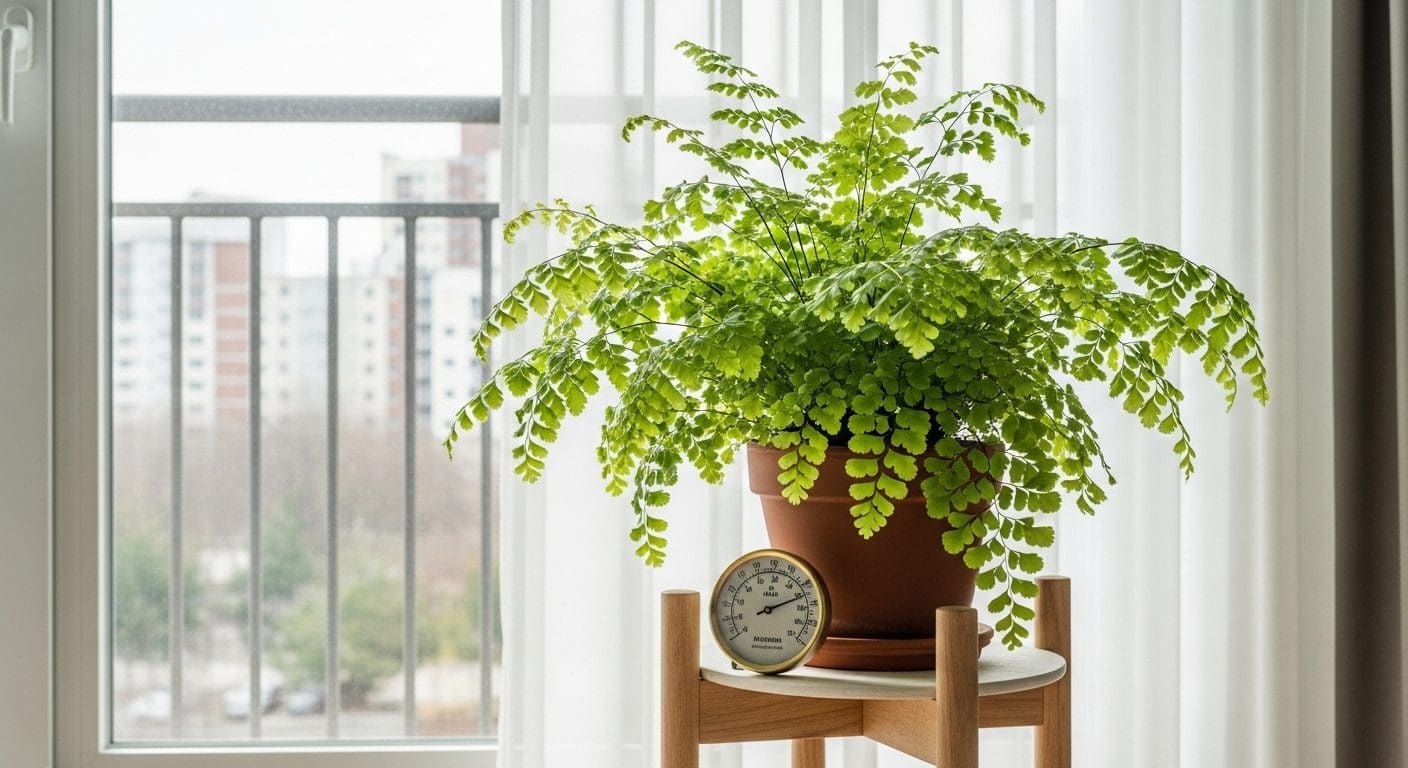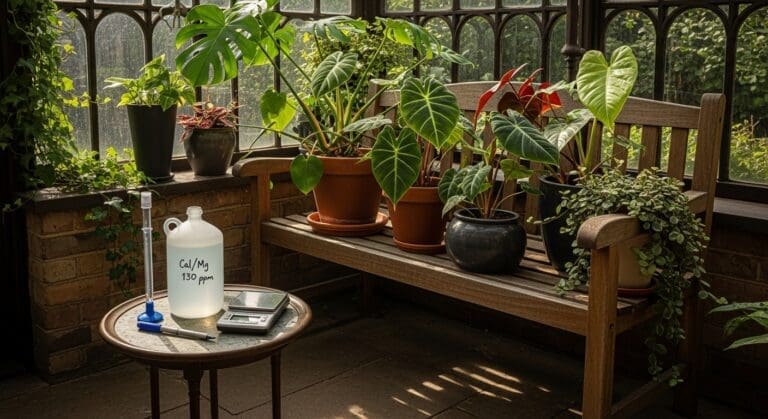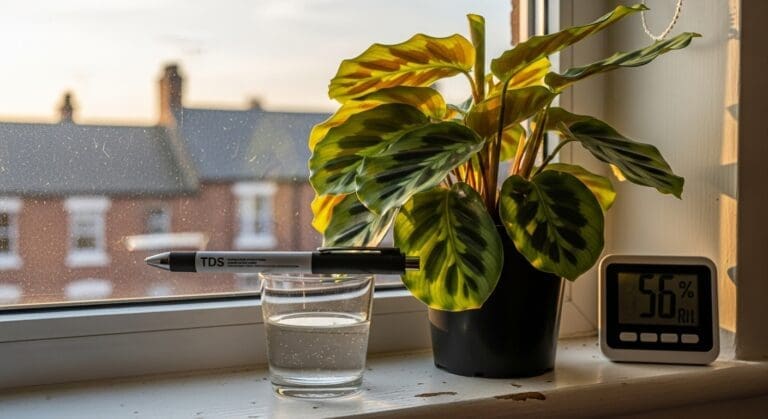Maidenhair ferns are heartbreakers—ethereal, lacy, and infamously dramatic when thirsty. If you’ve ever come home to crispy fronds after a long workday or a weekend away, you’re not alone. This guide turns Maidenhair Indoors: A Real-World Watering Schedule for Busy Flats into something you can actually live with, even in a small apartment where radiators hum in winter and window space is precious. “I still catch myself checking the pot by feel before I put the kettle on—old habits that keep my Maidenhair happy.”
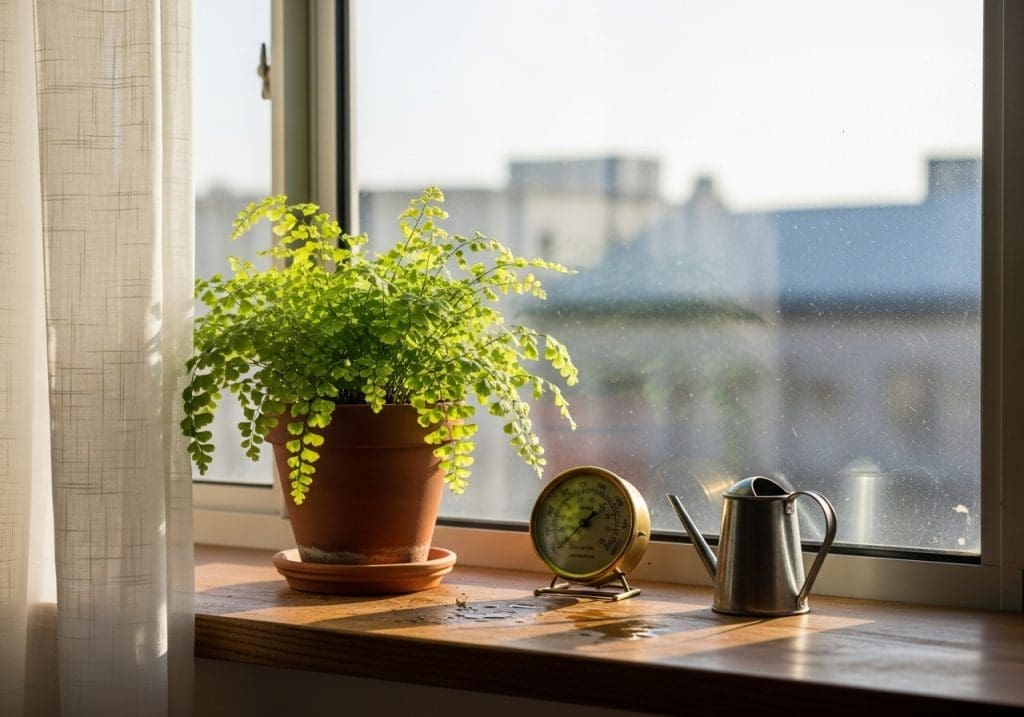
What Makes Maidenhair Tricky (and Why You Can Still Win)
Maidenhair (Adiantum spp.) evolved under forest canopies where light is soft, air is humid, and soil stays evenly moist. Indoors, that translates to bright-indirect light, steady humidity (55–70% RH), and a consistent watering rhythm. The fronds are thin and lose water quickly; when the root zone dries hard, it sulks—fast.
The good news? Once you match watering to your home’s reality, it stabilizes. Consistency beats intensity. A small, regular drink on the right cadence is far better than a deep drench after a dry spell. Will it survive your small flat with a radiator under the window? Yes—if you plan your rhythm around it.
Maidenhair Indoors: A Real-World Watering Schedule for Busy Flats (Month-by-Month)
The schedule below assumes a 12–15 cm plastic pot, bright-indirect light, peat-free mix that holds moisture but breathes, and average home humidity around 55–65% RH. Terracotta dries faster; lower light slows everything. Treat these as ranges you’ll calibrate (next section) rather than fixed rules.
- January: every 5–7 days
- February: every 4–6 days
- March: every 3–5 days
- April: every 3–4 days
- May: every 2–4 days
- June: every 2–4 days
- July: every 2–4 days
- August: every 2–4 days
- September: every 3–4 days
- October: every 3–5 days
- November: every 4–6 days
- December: every 5–7 days
Quick swaps: In terracotta, shift each range 1–2 days shorter. In a lower-light room, shift each range 1–2 days longer. If your humidity dips under 45% (radiator season), expect leaf edges to crisp unless you raise RH or water a touch more frequently.
Crucially, do not let the mix go bone dry. You can let the top 1 cm feel barely dry before watering, but the root zone should remain slightly moist. Wondering if weekends away are off the table? Not at all—there’s a travel strategy near the end.
Calibrate to Your Home: A Three-Step Watering Method
No two flats are identical. To land the right rhythm, “listen” to the pot instead of the calendar. I keep it simple:
- Finger test: Press the top 1 cm. If it’s just starting to feel dry, it’s time.
- Pot heft: Lift before and after watering for a week; learn the midpoint “drink me” weight.
- Wooden skewer: Insert for 5 minutes; if it comes out almost clean, water.
Water slowly until a little drains; discard saucer water so the crown doesn’t sit wet. If the mix ever shrinks from the pot edges (hydrophobic), bottom-water for 20–30 minutes, then return to slow top watering next time. Pro tip: log dates for two weeks; patterns jump out.
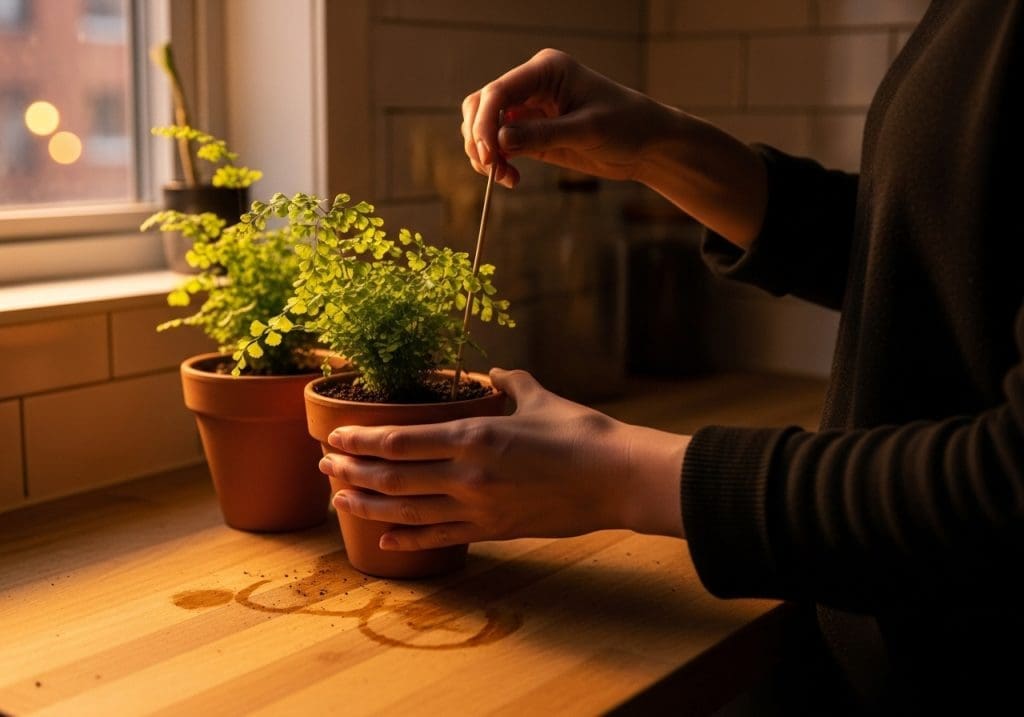
Light & Placement That Support the Rhythm
Maidenhair loves bright-indirect light—clear brightness but no hot rays landing on fronds. An east-facing window is perfect; a north window can work if the room is bright overall. For west windows, add a sheer curtain to soften late sun. Aim for ~2,000–5,000 lux (≈200–500 foot-candles) at leaf height; a free phone app gets you close.
Low light stretches watering intervals but weakens growth. Too much sun bleaches leaflets and speeds drying. If your only good spot is a bit dim, a small LED grow light on a timer (10–12 hours) fills the gap without turning your living room into a lab. For lighting details that tie into watering frequency, bookmark the pillar: Rare Ferns Indoors: The Complete Care Guide.
Humidity That Actually Works in Homes
In heated rooms, ambient RH often sits at 35–45%, which crisps delicate edges even if you water on time. Grouping plants raises the micro-climate slightly. Pebble trays help a little but won’t hit target alone. A quiet ultrasonic humidifier with a small hygrometer is the reliable route—set 60% and relax.
Keep gentle airflow so fronds don’t sit damp and cool (fungal invitation). If your flat is tiny, park the humidifier a couple of meters away on low. “I used to mist every morning; the hygrometer proved it barely moved the needle. The humidifier did more in ten minutes than weeks of misting.”
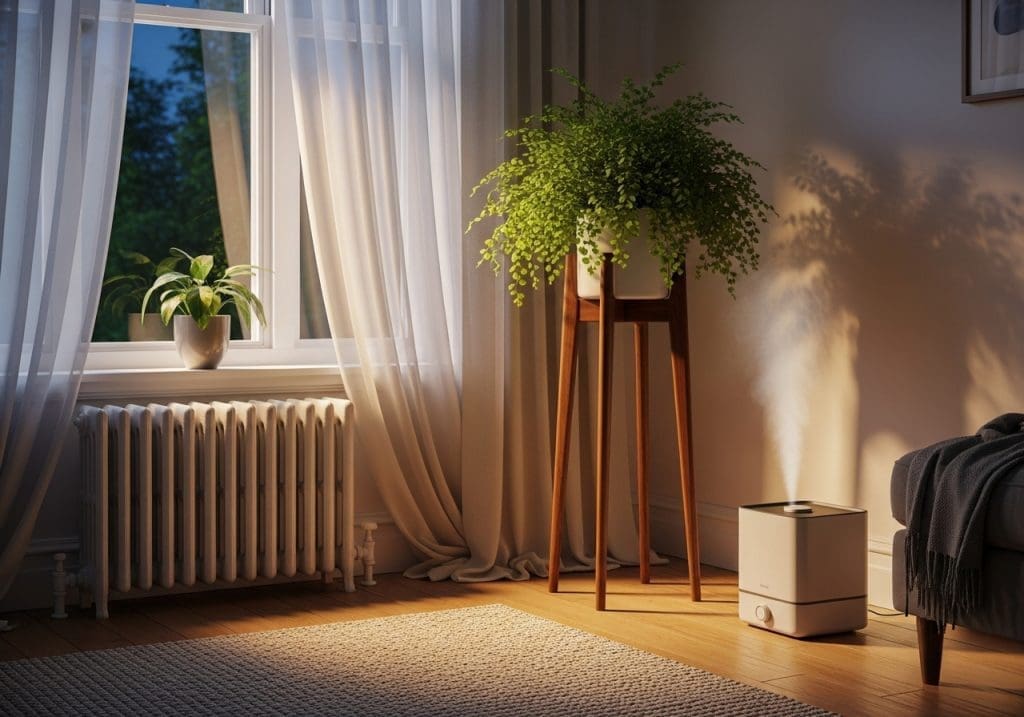
Cross-read later: Indoor Fern Humidity Guide and Fungus Gnats Control if you ever see tiny flies near the soil.
Water Quality Matters (and Why Leaves Spot)
Hard tap water or heavy chlorination can spot or crisp tips over time. Filtered water or collected rainwater is kind to Maidenhair; it keeps salts lower and pH closer to what ferns enjoy. If you notice white crust on the soil or limescale in the kettle, that’s your hint to switch.
Expert insight: “Most ferns appreciate evenly moist, humus-rich compost and protection from direct sun,” notes guidance from the Royal Horticultural Society, a trusted authority on houseplants. Read more on their fern care advice here: https://www.rhs.org.uk/houseplants/ferns.
If you must use hard water, flush the pot with plain water every 6–8 weeks to wash salts and consider a mild, chelated iron feed if new leaves look pale (interveinal chlorosis—pale tissue with green veins).
Pot & Mix Choices That Make Watering Easier
Choose a pot that helps your schedule rather than fights it. Plastic or glazed ceramic holds moisture longer (for busy weeks); terracotta breathes and dries faster (great if you tend to overwater). Size matters: going up only 2–3 cm prevents a cold, wet zone that lingers.
For a peat-free recipe that stays evenly moist yet airy, try 40% fine bark, 30% coco coir, 20% perlite/pumice, 10% worm castings. In warm, dry homes, add a bit more coco; in cool homes, add more bark/perlite. If you’re curious about the why, here’s the deeper dive: Best Peat-Free Potting Mix for Ferns.
Self-watering pots? They can work if you keep the top centimeter a touch drier to deter fungus gnats. Refresh the reservoir often and avoid sitting the crown (the central growing point) over constant wetness.
How Much Water Per Session?
Aim for a slow, thorough soak until a little drains. For a 12–15 cm pot, that’s usually 200–300 ml, depending on mix and dryness. The goal isn’t a number—it’s to rewet the entire root ball without drowning it. If the pot is unusually light, water in two passes five minutes apart so the mix rehydrates evenly.
After watering, empty the saucer, then check again by feel the next day. If the top is already dry, your room is likely warm or the pot is in a draft. Slightly increase humidity or shift the plant 30–60 cm further from the heat source.
Repotting, Feeding, and How They Shift the Schedule
After a repot, the fresh mix holds water differently. Keep the first week consistently moist and light a touch gentler; by week two, resume normal brightness. Hold fertilizer 3–4 weeks, then feed at ¼–½ strength every 4–6 weeks in active growth. Over-feeding shows up as brown margins—flush and dial back.
If you ever catch a faint sour smell or the pot stays heavy for days, you’re approaching root rot territory. Move to brighter-indirect light, increase airflow, and let the top 1–1.5 cm dry between waterings. If it worsens, follow this step-by-step rescue: Root Rot in Ferns — Save Your Plant.
Travel, Busy Weeks, and Rescue Moves
Got a three-day work trip or a long weekend? Water thoroughly the day before you go, group plants, and run the humidifier on low if you can. For a week away, set the pot on a capillary mat with the edge dipped in a water tray so it wicks slowly (wicking = water moving through fabric by capillary action). In hotter spells, it’s worth asking a neighbor for one mid-week check.
If you return to drooping fronds, don’t panic. Water slowly, raise humidity to 60–65%, trim crispy bits, and give bright-indirect light. Many Maidenhairs bounce back if the root crown is still firm and alive.
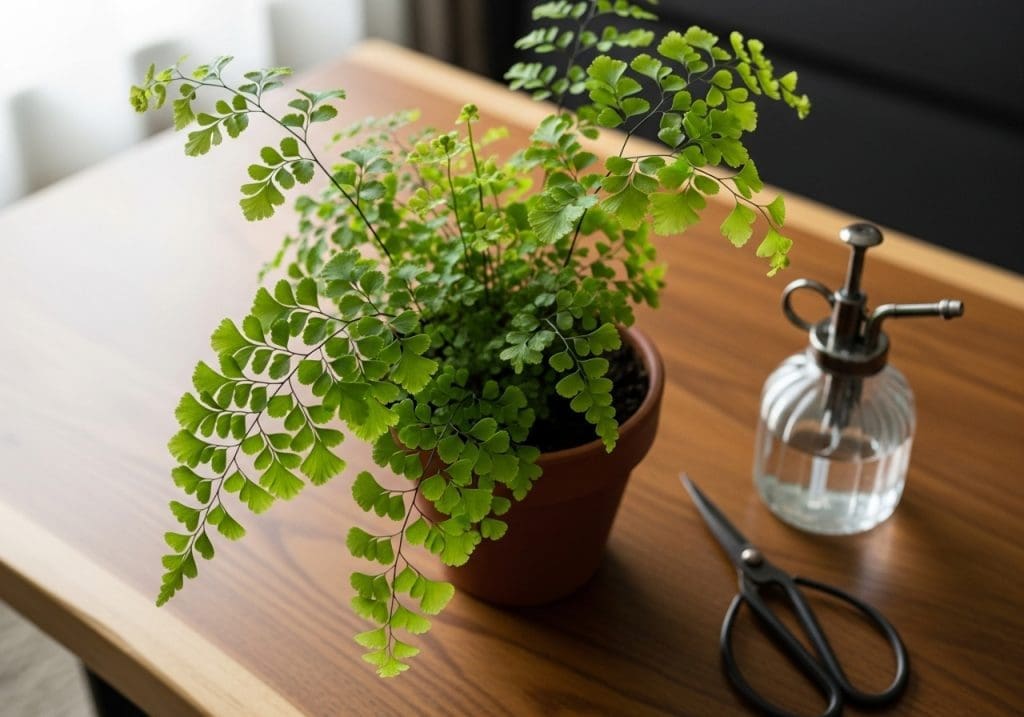
Troubleshooting: Real Problems, Real Fixes
Crispy tips despite frequent watering? Humidity is the missing piece. Lift RH to 55–65%, add gentle airflow, and keep the top centimeter from drying completely.
Yellowing overall? You may be overwatering in low light. Brighten the spot and let the top 1 cm dry before the next watering. If new leaves look pale with green veins, consider water quality and a mild iron supplement.
Tiny flies near the soil? Those are fungus gnats. Let the surface dry slightly between waterings, bottom-water for a while, and use sticky traps. Cross-read: Fungus Gnats Control.
Leaflets falling off after sun? That’s scorch. Step back from harsh rays or add a sheer curtain.
A Note on Routine and Joy
Set a reminder—Tuesday, Friday for spring and summer, Wednesday in winter—and stick to the feel-based check. Within a fortnight you’ll know your plant’s rhythm better than any chart. “When a fresh frond unfurls like a tiny green question mark, it feels like the flat is breathing with me.”
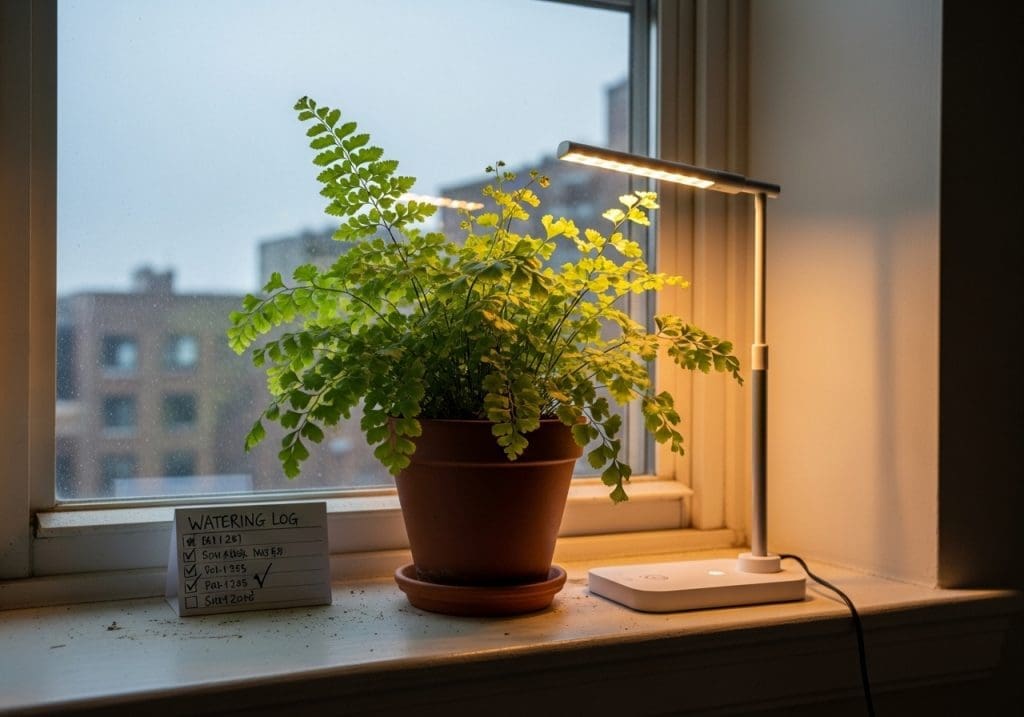
Save These Links for Later
- Pillar: Rare Ferns Indoors: The Complete Care Guide
- Humidity: Indoor Fern Humidity Guide
- Water Quality: Safer Watering for Delicate Ferns
- Potting Mix: Best Peat-Free Potting Mix for Ferns
- Root Rot: Root Rot in Ferns — Save Your Plant

RarePlantCare Editorial Team produces expert content on rare plants.
Our articles are AI-assisted and human-edited before publication.
We aim to provide practical, evidence-based guides for plant lovers worldwide.
Learn more about our Editorial Policy


